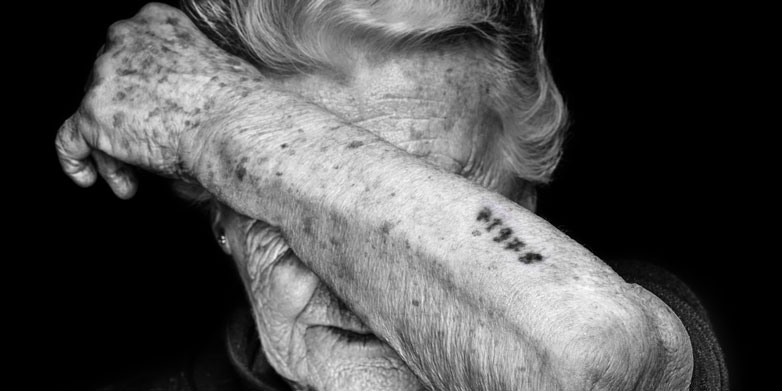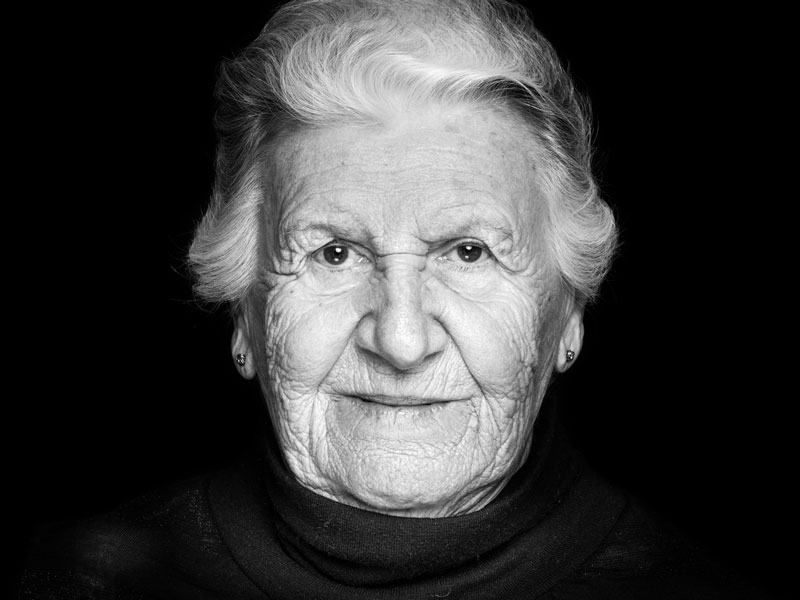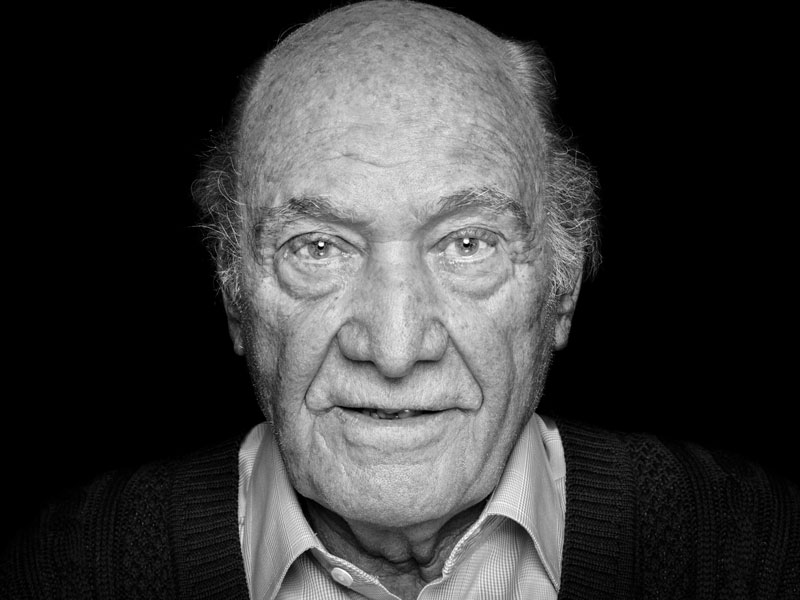The stories of survivors and life after the Holocaust
The "Last Swiss Holocaust Survivors" exhibition, which opens today at the ETH Zurich Archives of Contemporary History, tells the stories of how fourteen eyewitnesses survived the Holocaust and then went on with their lives.The exhibition has been extended until 15 June 2017.
(Updated: )
Some never spoke about it for the rest of their lives, others only when they were much older. Nina Weil was over 30 before she spoke about the Holocaust for the first time, and did so only with her husband. The two had many conversations before Weil was able to speak publicly about what she experienced in the concentration camps of Theresienstadt and Auschwitz. She is one of the last eyewitnesses in Switzerland; when she talks about the persecution of the Jews during the Second World War she uses her maiden name, because it is the name “under which she suffered”. Born in 1932 in Klatovy (in the present-day Czech Republic), she has lived in Switzerland with her husband since 1968, when she was granted asylum after the reform attempts of the Prague Spring were suppressed.
Eduard Kornfeld came to Switzerland in 1949. Suffering from pulmonary tuberculosis, he spent four years in a sanatorium in Davos. Patients had to spend long hours lying down during treatment, and so they told their stories. Eduard Kornfeld was one of these storytellers, and he has not been silent since. He continues to tell of the horrific things he experienced. Born in 1929 near Bratislava in present-day Slovakia, during the war he was a prisoner in the concentration camps of Auschwitz and Dachau. He survived, thanks to a lot of luck and perseverance. The experience taught him “to never give up”. When he talks to students, for whom the Second World War is already in the distant past, he tells them: “You have to question everything. You can’t be complacent. You must have your own opinion.”
Finding their own words
Around 450 Holocaust survivors are still living in Switzerland today. Most of them came to the country after the Second World War. In the film and photo exhibition The Last Swiss Holocaust Survivors, fourteen eyewitnesses describe what they lived through during the Holocaust and how they went on with their lives afterwards. These survivors include Nina Weil and Eduard Kornfeld. The travelling exhibition is open from 2 May to 3 June 2017 at ETH Zurich’s Archives of Contemporary History and will then move on to other locations. The exhibition was planned by the Gamaraal Foundation, which supports Holocaust survivors in need and works to educate people about the Holocaust. The Archives of Contemporary History have provided an academic framework for the exhibition and organised tours and a panel discussion on Holocaust education (see info box). The exhibition is one of the activities taking place in 2017 now that Switzerland has taken on chairmanship of the International Holocaust Remembrance Alliance (IHRA) for a year.
“In the exhibition, Holocaust survivors from all over Switzerland tell their life stories,” explains Anita Winter, Founder and President of the Gamaraal Foundation. “They speak about their experiences and memories, some of which can barely be expressed in words.” Winter’s father was one of 20,000 Jewish refugees who fled to Switzerland during the Second World War. Her mother survived in France. “Holocaust survivors must find their own way to tell their stories so that they can share their memories without it causing them excessive distress,” adds Gregor Spuhler, Head of the Archives of Contemporary History.
Letting the Holocaust speak through images
The exhibition therefore relies on the effect of images and narrative. Its focal point is 14 large-format portrait photos and filmed interviews with the eyewitnesses. All the portraits are black and white. The windows of the archive’s seminar room are blacked out and the room is darkened, which directs the attention to the faces pictured in the photographs, allowing the portraits to create an unusual closeness between the image and the viewer. It also sparks interest in the survivors’ stories. Brief biographies, quotations and filmed interviews are arranged around the 14 individual stories to encourage further involvement with the survivors.
Photographer Beat Mumenthaler and director Eric Bergkraut present their photos and films in a uniform way to underscore the shared outcome experienced by all survivors. The different faces and ways they tell their stories then re-emphasise the individuality of each person. For visitors, this makes the Holocaust something personal, visible and comprehensible – and the sense of lasting fear and sorrow connected with the plea of “Never again” is also palpable.
Life stories and historical explanation
This is a point of departure for Holocaust representation: “The artistic quality of the photos and films creates a very moving closeness with the survivors,” says Daniel Nerlich, Deputy Head of Archives. “For the Holocaust Education in Switzerland, this approach is completely novel.” The Archives of Contemporary History are part of ETH Zurich’s Institute of History and have been the official documentation centre for contemporary Jewish history since 1995. In addition to cataloguing historical documents and legacies, the archives also aim to educate people. The tours of the exhibition and archives are intended to demonstrate to younger generations the importance of democracy, rule of law, separation of powers, and tolerance. Twenty school classes have already made plans to visit the exhibition.
“These individual life stories are very important to raise awareness about the Holocaust and the crimes committed during that time,” says Gregor Spuhler. “Yet even when you put them all together in one place, no complete picture emerges that can explain the Holocaust in historical terms. That’s only possible when you look beyond the victims to include the perpetrators and bystanders, while taking into account the historical processes and structures at work.”
Exhibition and panel discussion
The Last Swiss Holocaust Survivors
2 May to 3 June 2017
Archives of Contemporary History, ETH Zurich, Hirschengraben 62, 8001 Zurich
Opening hours
Monday to Friday 9.00 a.m. to 5.00 p.m.
Public tours:
Wednesday 3/10/17/24/31 May 2017, 12.30 p.m. to 1.00 p.m.
Tuesday 09/16/30 May 2017, 18.00 p.m. to 18.30 p.m.
Group tours by arrangement: .
Panel discussion Holocaust Education – to what end?
At a panel discussion in May, experts will discuss the future of scholarly and pedagogical reappraisals of the Holocaust as well as the opportunities and risks offered by various approaches (discussion in German).
23 May 2017, 6.00 p.m. – 7.15 p.m.
Archives of Contemporary History, ETH Zurich
Hirschengraben 62, 8001 Zürich
Please register in advance: / 044 632 40 03
Exhibition extended until 15 June 2017
The Last Swiss Holocaust Survivors exhibition at the Archives of Contemporary History has been extended until 15 June 2017. The exhibition will have special opening hours on Saturday, 3 June; it will remain closed on Whit Monday, 5 June.
Guided tours
Tuesdays: 30 May, 6 and 13 June 2017; 6–6.30 p.m.
Wednesdays: 24 and 31 May, 7 and 14 June 2017; 12.30–1 p.m.



